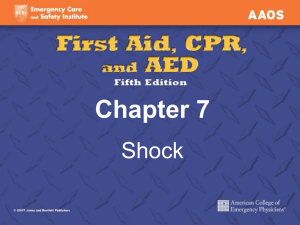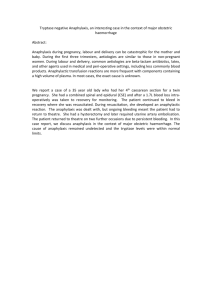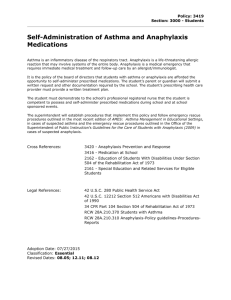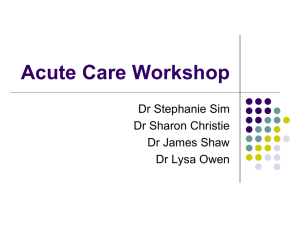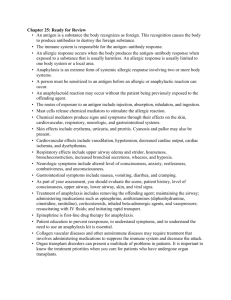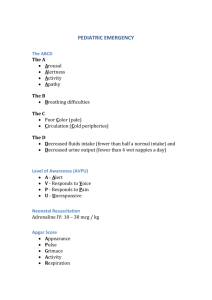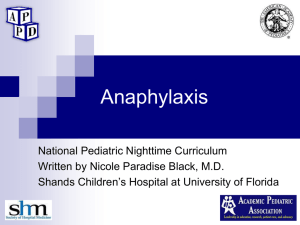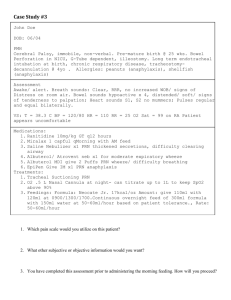NCP Nursing Care Plan for Anaphylaxis Shock. Anaphylaxis is a
advertisement
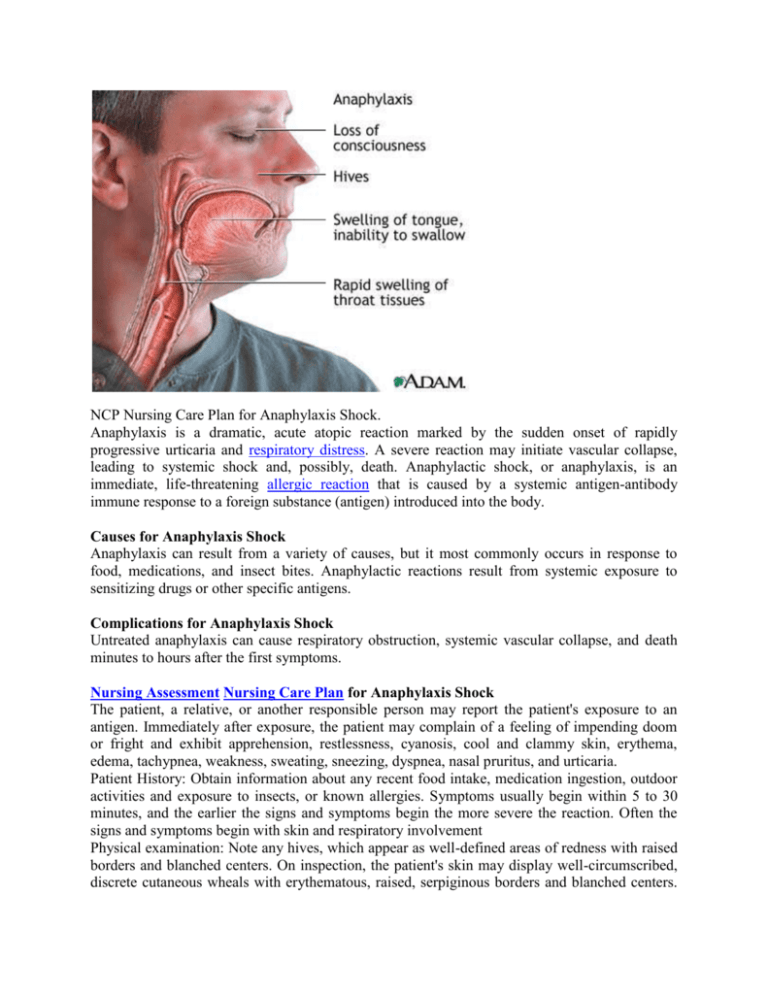
NCP Nursing Care Plan for Anaphylaxis Shock. Anaphylaxis is a dramatic, acute atopic reaction marked by the sudden onset of rapidly progressive urticaria and respiratory distress. A severe reaction may initiate vascular collapse, leading to systemic shock and, possibly, death. Anaphylactic shock, or anaphylaxis, is an immediate, life-threatening allergic reaction that is caused by a systemic antigen-antibody immune response to a foreign substance (antigen) introduced into the body. Causes for Anaphylaxis Shock Anaphylaxis can result from a variety of causes, but it most commonly occurs in response to food, medications, and insect bites. Anaphylactic reactions result from systemic exposure to sensitizing drugs or other specific antigens. Complications for Anaphylaxis Shock Untreated anaphylaxis can cause respiratory obstruction, systemic vascular collapse, and death minutes to hours after the first symptoms. Nursing Assessment Nursing Care Plan for Anaphylaxis Shock The patient, a relative, or another responsible person may report the patient's exposure to an antigen. Immediately after exposure, the patient may complain of a feeling of impending doom or fright and exhibit apprehension, restlessness, cyanosis, cool and clammy skin, erythema, edema, tachypnea, weakness, sweating, sneezing, dyspnea, nasal pruritus, and urticaria. Patient History: Obtain information about any recent food intake, medication ingestion, outdoor activities and exposure to insects, or known allergies. Symptoms usually begin within 5 to 30 minutes, and the earlier the signs and symptoms begin the more severe the reaction. Often the signs and symptoms begin with skin and respiratory involvement Physical examination: Note any hives, which appear as well-defined areas of redness with raised borders and blanched centers. On inspection, the patient's skin may display well-circumscribed, discrete cutaneous wheals with erythematous, raised, serpiginous borders and blanched centers. Angioedema may cause the patient to complain of a lump in his throat, or you may hear hoarseness or stridor. Wheezing, dyspnea, and complaints of chest tightness suggest bronchial obstruction. They are early signs of impending, potentially fatal respiratory failure. Auscultate the patient’s blood pressure with a high suspicion for hypotension. Auscultate the patient’s heart to identify cardiac dysrhythmias, which may precipitate vascular collapse. Palpate the patient’s extremities for signs of cardiovascular com Diagnostic tests for Anaphylaxis Shock Usually No tests are required Nursing diagnosis Nursing Care Plan for Anaphylaxis Shock Common nursing diagnosis found in nursing care plan for patient with Anaphylaxis • Acute confusion • Acute pain • Anxiety • Decreased cardiac output • Deficient fluid volume • Deficient knowledge (avoidance strategies) • Impaired gas exchange • Impaired skin integrity • Ineffective airway clearance • Ineffective breathing pattern Nursing outcomes for Anaphylaxis Shock Nursing outcomes Nursing Care Plan for Anaphylaxis, patient will: Reoriented to the situation and his surroundings. Express feelings of comfort and decreased pain. Verbalize measures to reduce his anxiety level. Cardiac output and heart rate will remain within normal range, and his pulses will remain palpable. Maintain an adequate fluid volume. Verbalize measures to avoid allergens. Ventilation and oxygenation will remain adequate. Wounds or lesions will heal without complications. Maintain a patent airway. Maintain a respiratory rate within five breaths of baseline. Nursing interventions Nursing Care Plan For Anaphylaxis Shock Delirium Management Provision of a safe and therapeutic environment for the patient who is experiencing an acute confusional state. Reality Orientation Promotions of patient’s awareness of personal identity, time, and environment. Surveillance Safety Purposeful and ongoing collection and analysis of information about the patient and the environment for use in promoting and maintaining patient safety 1 Pain Management Alleviation of pain or a reduction in pain to a level of comfort that is acceptable to the patient. Analgesic Administration Use of pharmacologic agents to reduce or eliminate pain. Environmental and Comfort Management Manipulation of the patient’s surroundings for promotion of optimal comfort Anxiety Reduction minimizing apprehension, dread, foreboding, or uneasiness related to an unidentified source or anticipated danger. Provision of a modified environment for the patient who is experiencing a chronic confusional state. Calming Technique to Reducing anxiety in patient experiencing acute distress Hemodynamic Regulation Optimization of heart rate, preload, after load, and contractility. Cardiac Limitation of complications resulting from an imbalance between myocardial oxygen supply and demand for a patient with symptoms of impaired cardiac function. Circulatory Care Mechanical Assist Devices Temporary support of the circulation through the use of mechanical devices or pumps Fluid Management Promotion of fluid balance and prevention of complications resulting from abnormal or undesired fluid levels. Hypovolemia Management: Reduction in extracellular and/or intracellular fluid volume and prevention of complications in a patient who is fluid overloaded. Shock Management Volume: Promotion of adequate tissue perfusion for a patient with severely compromised intravascular volume. Teaching Individual Planning, implementation, and evaluation of a teaching program designed to address a patient’s particular needs. Learning Facilitation to promoting the ability to process and comprehend information. Learning Readiness Enhancement to Improving the ability and willingness to receive information Respiratory Monitoring to Collection and analysis of patient data to ensure airway patency and adequate gas exchange. Oxygen Therapy Administration of oxygen and monitoring of its effectiveness. Airway Management Facilitation of patency of air passages Wound Care Prevention of wound complications and promotion of wound healing Cleansing, monitoring, and promotion of healing in a wound. Airway Management Facilitation of patency of air passages. Respiratory Monitoring Collection and analysis of patient data to ensure airway patency and adequate gas exchange Ventilation Assistance: Promotion of an optimal spontaneous breathing pattern that maximizes oxygen and carbon dioxide exchange in the lungs
